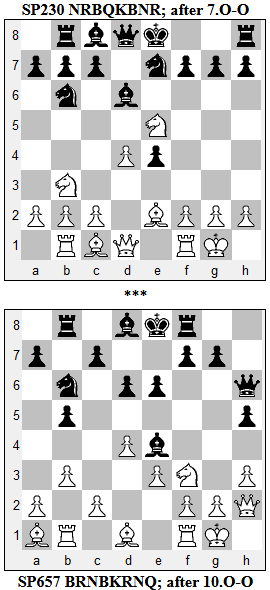The point where one of the players castles (or otherwise forfeits the castling option) is often a good place to study the game. The previous moves have been pure chess960 (whatever that means), the following moves (up to the point where the other player castles) are a mixture of ideas from chess960 and from traditional chess, and the rest of the game will be equivalent to traditional chess. A chess960 opening can thus be logically divided into three phases.
The top diagram contrasts dramatically with the corresponding position in 'Seeds of Defeat'. Neither player has an advantage (which can be considered a moral victory for Black), although there is plenty of play in the position. The game continued 7...f6 8.Nc4 Nxc4 9.Bxc4 b5 10.Be2 O-O, where both players have castled; the position is still balanced, and there is still plenty of play. At this point I looked at three moves with different objectives -- a4, Nc5, c4 -- eventually choosing 11.Nc5. The game continued 11...f5 12.a4 b4 13.Bc4+ Kh8 14.Qh5 Ng6 15.b3 a5, and I was gradually outplayed.
Note that the start position SP230 is almost the same as SP518. The Rook on the a-file and the Knight on the b-file have been switched. This might have played a role in my thinking.

The bottom diagram also contrasts dramatically with the position in 'Seeds of Defeat'. Black's Queen and Bishops are more active than White's corresponding pieces, already giving Black the upper hand. Black played the natural move 10...O-O, and the game continued 11.Rc1 Nd5 12.Bb2 a5 13.a3 Bf6 14.Nd2 Bg6 15.Bf3 a4 16.b4 c5. Here Black has a space advantage and Black's pieces are better coordinated than White's. White must have played poorly and continued to be outplayed for the rest of the game, which lasted another 20 moves.
During all four games using the two SPs, I had trouble formulating a plan and was convinced that my opponents understood the evolving positions better than I did. The results -- four losses for me -- confirm this.

No comments:
Post a Comment